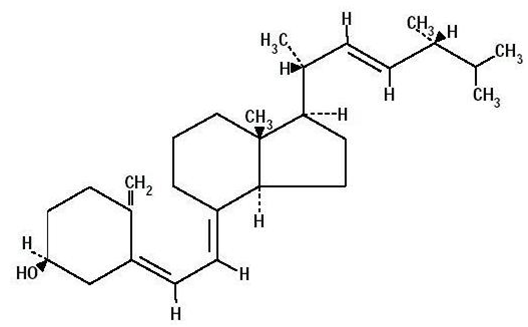
Composition
- Each Uncoated Tablet Contains:
- Calcium Carbonate IP
1250 mg
- Vitamin D3 IP
250 IU
Packing
- 10x15
(Blister)
MRP
- 58
Overview
This combination medication is used to prevent or treat low blood calcium levels in people who do not get enough calcium from their diets. It may be used to treat conditions caused by low calcium levels such as bone loss (osteoporosis), weak bones (osteomalacia/rickets), decreased activity of the parathyroid gland (hypoparathyroidism), and a certain muscle disease (latent tetany). It may also be used in certain patients to make sure they are getting enough calcium (e.g., women who are pregnant, nursing, or postmenopausal, people taking certain medications such as phenytoin, phenobarbital, or prednisone). Calcium plays a very important role in the body. It is necessary for normal functioning of nerves, cells, muscle, and bone. If there is not enough calcium in the blood, then the body will take calcium from bones, thereby weakening bones. Vitamin D helps your body absorb calcium and phosphorus. Having the right amounts of vitamin D, calcium, and phosphorus is important for building and keeping strong bones.
Indications
- Osteoporosis
- Osteomalacia/Rickets
- Hypoparathyroidism
- Pregnant, nursing or postmenopausal women
- Normal functioning of nerves, muscles, cells, bones
Warnings
Always get advice from a healthcare professional before taking this medicine if:
you are allergic or sensitive to or have had a reaction to any of the ingredients in the medicine
this medicine is for a child or an adolescent
you have a history of kidney stones or calcium deposits in your kidneys
you have kidney problems
you have high levels of calcium in your blood or urine, or this has been caused by having certain conditions such as hyperparathyroidism, cancer or bone tumours
your osteoporosis is caused by being immobile
you have vitamin D poisoning
you have sarcoidosis
you are taking calcium and vitamin D supplements
you have a history of fructose intolerance, glucose-galactose malabsorption or sucrase-isomaltase insufficiency
If overdose is suspected, contact a poison control center or emergency room immediately.Pregnancy and breast-feeding: This medicine is not known to cause any problems during pregnancy or while breast-feeding. However, as with all medicines, you should seek medical advice from your doctor before taking this medicine if you are pregnant or are breast-feeding.
Contraindications
This drug is contraindicated in patients with hypercalcaemia and/or hypercalciuria, nephrolithiasis, hypervitaminosis D, hypophosphataemia.
Side Effects
Constipation
Nausea/vomiting
Loss of appetite
Unusual weight loss
Mental/mood changes
Change in the amount of urine
Bone/muscle pain, headache
Increased thirst
Increased urination
Weakness
Tiredness
Fast/pounding heartbeat
Dosage
Oral:
Tablet may be taken with or without food.
Disclaimer:To be taken only after consulting with the doctor.
Storage
Store at room temperature away from light and moisture. See packaging for the exact temperature range. If you have any questions about storage, ask your pharmacist. Do not store in the bathroom. Keep away from children and pets.
Do not flush medications down the toilet or pour them into a drain unless instructed to do so. Properly discard this product when it is expired or no longer needed. Consult your pharmacist or local waste disposal company for more details about how to safely discard your product.
For Professionals
Pharmacokinetics
Absorption:Calcium Carbonate: About 15-25% gets absorbed in the GI tract and converted to calcium chloride by gastric acid. Some of the calcium is absorbed in the intestines. Calcium is absorbed in soluble, ionized form; solubility of calcium is increased in an acidic environment.
Vitamin D: Well-absorbed in the GI tract in the presence of bile.
Distribution:
Calcium Carbonate: Crosses placenta, enters breast milk.
Vitamin D: Bound to a specific α-globulin and can be stored in adipose & muscle tissue for long periods of time. Slowly released from storage sites & skin where it is formed in the presence of sunlight or uv light. It may distribute into breast milk.
Metabolism:
Vitamin D: Hydroxylated in the liver by the enzyme vitamin D 25-hydroxylase to form 25-hydroxycholecalciferol (calcifediol). Further hydroxylated in the kidneys by the enzyme vitamin D1-hydroxylase to form the active metabolites 1,25-dihydroxycholecalciferol (calcitriol). Then metabolism also occurs in the kidneys, including the formation of the 1,24,25-trihydroxy derivatives.
Excretion:
Calcium Carbonate: Mainly in the faeces as unabsorbed calcium; urine (20%).
Vitamin D3: Mainly in the bile & faeces with only small amounts appearing in urine.
Interactions
The following medicines may interact with this medicine:
- Tetracyclines - you should take tetracyclines either two hours before or four to six hours after taking this medicine
- Biphosphonate, sodium fluoride or fluoroquinolones- you should take bisphosphonates, sodium fluoride or fluoroquinolones at least three hours before taking this medicine
- Iron, zinc or strontium ranelate - you should take iron, zinc or strontium ranelate and this medicine at least two hours apart
- Estramustine or thyroid hormones - you should take estramustin or thyroid hormones and this medicine at least two hours apart
- Levothyroxine - you should take levothyroxine and this medicine at least four hours apart
- Thiazide diuretics
- Corticosteroids
- Cardiac glycosides such as digoxin
- Ion exchange resins such as cholestyramine
- laxatives such as paraffin oil
- Phenytoin
- Barbiturates
- Orlistat
- Calcium and vitamin D preparations
- Etridonate
For Patients
How to use this medicine:
- Use this medicine as directed by your doctor. Check the label on the medicine for exact dosing instructions.
- Take tablet by mouth with or without food with a full glass of water (8 oz/240 mL).
- If you miss a dose, take it as soon as you remember. Continue to take it as directed by your doctor or on the package label.
Chemistry
Calcium carbonate is an odorless, tasteless powder or crystals that occur in nature. It is insoluble in water and ethanol.

